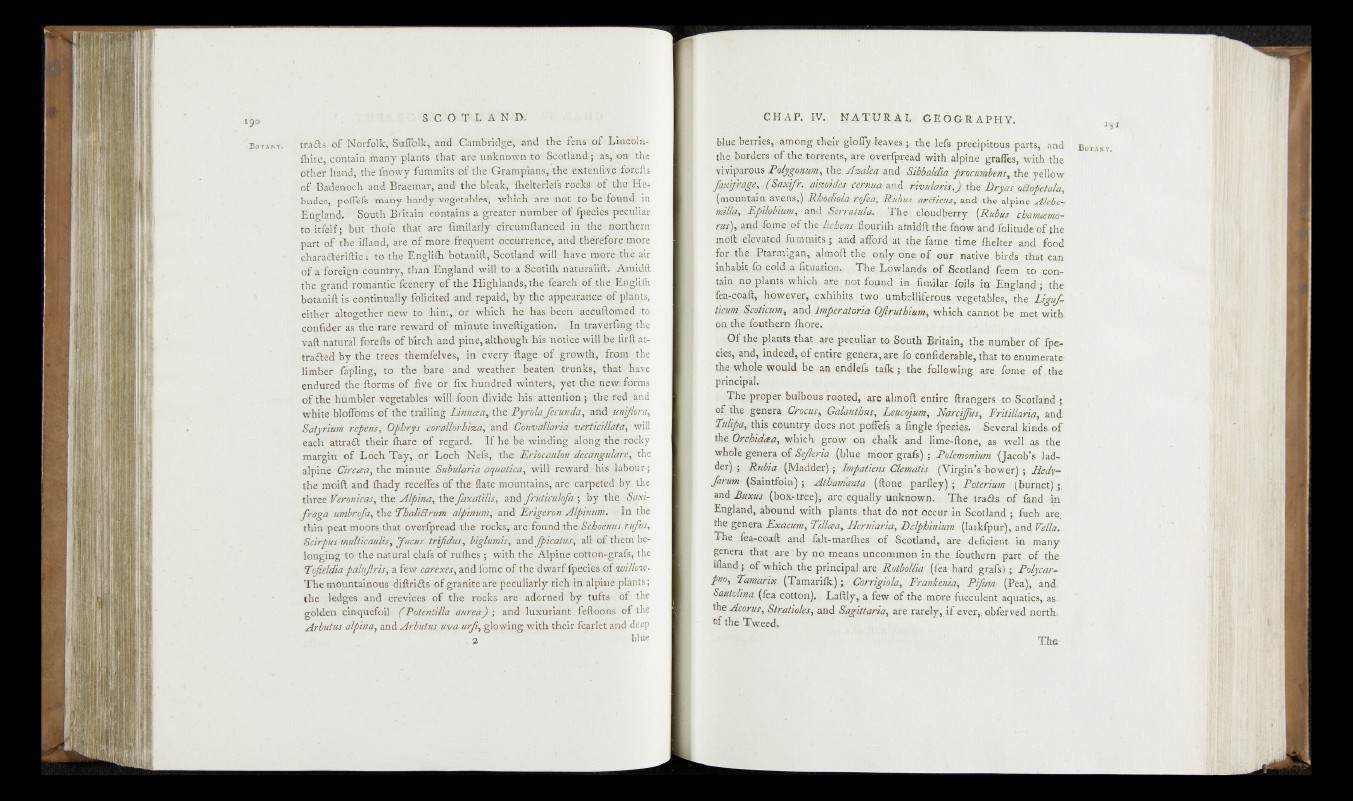
trkifts o f Norfolk, Suffolk* 'and Cambridge’, ’ .and the fens o f ILmcoln-
fhire, contain many plants that) are '»ua-knoWn.t© .Scotland,’; a'S,»oa rtbe
Other' Hahdf .thetfeO’wy fuffaimts'of ;Grampians*)the feist e iA h ff« cells
<jf Badenoch-and Braettiar, and the bleak, fhclterlefs rooks „ofirAetHe-
badesj po'ffefs marry hardy ’VtegetkMes} which a fe 'm d t tO.Aetfoamd in
Ehglsud. T'Sdrtth Bfitain contains' a greater -number h f fpecies peculiar
ro'itfelf; bud'-Adle-* th a t ire fundlarly. jeircumftanced in ithe nontkern
part of*the iffand, aretof mbre frequent‘dc&urrencevtahd.theftefQreiinore
chark(MriSfei^$#it^-feti^ifli botanift, iScotland1 'will h a te m&rejsAe-air
e^ahfo^gtticduntryV t^ an 'England will to a Scotifh naturaiift. Amidft
the grand romkntic feenery o f the -Highlands, the fearch Ih
botanift is eoritiiina%;folicited and repaid, by Ad
either altogether new to-Aim,, or which h eA as.h e eh ..aecuftomed to
confider aa A e rare:reward of'miriute inveftigatibjnf In tJ’avetfingjthe
vaft natural forefts of birch and pine, although h'is notice willjberfirft at-
tradted by the trees tKemfelves, inA v e fy -ftage o f growth, .fr-om p-he
limber fapling, ■ to the bare and weather". beatero Trunks, t h ^ ^ y e .
endured the fibrins o f five or fix hundred winters) yet A e ; nevw forms
o f the humbler vegetables’ wilMobn divide .Mst a tten tib n y Ay.feed Bhd
white bloffbms oftdie trailing L in n a a , the Pyrolafocunda, «-add- uniflora,
Saiyriw fi repens, Opb'rys coralldthhea, and JGo^aUiiridk)ektieillata\ twill
parh kttraQ; their Aare o f regard. >ff K l|I^U if e ^ ^ ^H y ^ J tb lk o i8 k y
margin- o f Lcfeh Tay, or L chA Nefs,' tb eiE /ib ca u h n jka S n g u la rejm ii
alpih& Chrcau, the minute Subutatia aquatica, will reward Hift^Igbpbr f
the moift and Aady: needles Bf Afe-flate mountains, a re cajpetedAy|tih«
th ree yerenicasjiihe A tp m a ,thefa x a fiiis, ?sxA'frutivuhfo‘\ by <th%ri&<ixi-
fo-dgd umbrofa, the 1 ’baliBrutti alpinum, and M rigeroftA lpitium ■ Infphe,
thin peat moors th a t overfpread th e rm fesy& ei& nfoikfae Egkam us.ytfu^
Scitpiis tttulticaulu, yuciis trifidus, biglumis, and JpicatflSi,s ah o£ them belonging
to the natural cfcdsof rdSfeesy with the-AIpindiieftgwfigtafSj the
‘PsfoslSapiiluJlrisijiL fetfr earexes^’%&& lome o f the dwarf fpecies off ifft/fri?.
T h e mountainous difttiSts; o f granite torep e c u l i a r l y a l p i n e | p i l k n t s ;
the ledges and erevieea o f the rdcks are": addxUed^l^ itd&S'tpf fidi6
golden, eihqnefoil ( PotenHHtt AureAfot a n d luxuriant:fefk)phs7 ofithe
Arbutus alpina, and A rbutus U vaurji^ glqwfog with their fc^rlet and d p p
> 2 1 blue
WuehfjrjiEiSj! .among :|MRi^ofiyskaygs';:; the. iefs precipitous parts, and
tfe -W d e rs ?of jthe, %0«®«%- are iqvgrfpreae! with alpine grades, with, the
viviparous- Pdfygm um , the A m k a m A SM ahfia prscumbens, the yellow
w zoffas ctxm fta fiA r iv u la m ,) the D ryas vfapetala,
(roquofain an d .th e alpine AlehemMkr'M
UM wmin cloudberpy; (Rubus chamsemtrus),
and f w -.of the lik e n s a Aid ft the fnow and fohtnde of the
tnoft ejeyated A dm its 5 and a i% d ia t the lame./thne Aejter -and food
for 'the .Ptarmigan, therxoialy.o^e. ©f our native birds that can
inhabit £o. gold, a htuadoi}. .T h ^ j^w la n d s o f Scotland feen? to gon-
Which,., ace |gu,^d ^n fimilar fojls in ptigland.j the
fea-cqaft,,; h^yveverj.te^hibit^ft^p ,nmhoU%rous vegetables,, the JJg u f-
tw m bkotf'wwi ikiid fa pm p o g fa with
o.® the, foythern Aore., ;
Of the .plants that are.peqnliar to ^ q u th Britain, th.e number q i
cies,. and, indeed, o f ■entir.e g e n e r a t e h i coBfiderable^ that to enumerate
the; whole would, bo an endhdii talk j the fqllqwing ate, f<3P>e qf . the
principal.; :
The proper bttlbous V.oqteds/.affe almoft e n tire . ftr^nger-s to Scotland
XiilipQi thi^ country does not ppiffqfs.ja fingle^fpegies. ,%.%veral kinds, o f
the Orefndau, which, grow ,qn ,ehaJk and lime-ftqtie, as well} as the
whole genera o fA eJerw (blue*.mpqr.graft) ; Polmoniutn {Jaeob’§ ladT
der) p Rtibia 1 (Madder); Impatient Clematis-, ftKfegin’^hqweE).; H edy-
forum (Saintfoin) ; Athama?ita ^ ft one parfley). j. (■ Pofisriunr (burnet)
and B hxus (box-tree), are equally-unknown. T h e tra<a& o f Land in
England, aibound with plants A a t do not-.oecurinsSeotfand ‘r fuehs.a-re
the genera Exaeum, TtUaa, H erniaria, Delphinium (larkfpud)^ and Telia,.
The jfea-Goai|; apd falt-imarffiesplof Scotland, are deficient ini many
gqner,a.,that ar,e' by no, n^eans unconupon in> the. fquthern. part ,of the-
iflandjj o f which the (principal are RotboIUa (lea hard grafs),; Pvlycar-?-
pWy Tam arix (T am a r ilk .) , jCerrigiola^; forankenia^ . Pifom ' (PeaJ^ and.
Santolina ff^a cotton)^, Uaftly, a few o f the,more fiaqculqnt aquatics, as.
the Acorus, S tratiolfs, and Sagittaria, are rarely,, if ever,, qbferved nor As
of the Tweed..
B ota
Th&